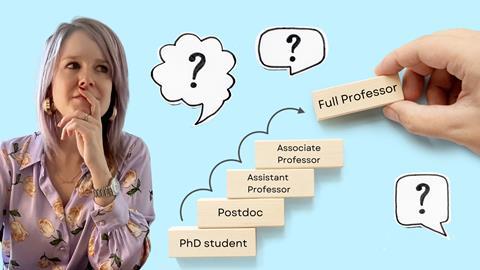
When talking to (PhD) students about their career aspirations, Isabelle Kohler has found that it is not always clear to them what a traditional academic career leading to a professorship entails: how does one become a full professor? And what does a professor actually do? In this instalment of Exploring Academia, she discusses the typical steps on the academic ladder and the tasks and responsibilities of a professor.
I frequently ask my (PhD) students about their career aspirations. It’s not just about mentoring them through the process, I genuinely enjoy our conversations about their futures. Some are still exploring their options, while others have a rough idea of where they want to go. Then there are those who know exactly what they are aiming for.
Among the latter group, I sometimes hear this resolute declaration: ‘I want to become a professor, Isabelle!’ I’m genuinely impressed when I hear this, not just because of their ambition, but because of the clarity they have about their path. When I was a master’s student, my own journey was not as clearly defined. I initially leaned towards community pharmacy before changing my mind and choosing a research-focused direction with a PhD. At the time, the idea of an academic career leading to a professorship was unfamiliar territory to me.
In my view, the traditional academic career path towards professorship is both straightforward and intricate. While the steps of the academic ladder may seem logical and uniform (i.e. from postdoc to full professor), they can vary significantly depending on the country – and even between institutions within the same country. It is also not uncommon for people to deviate from the traditional route, for example by skipping a few steps or returning to academia after a period in industry.
Let’s delve into the conventional academic trajectory in the Netherlands.
Step one: Postdoc
After completing a PhD, a logical next step for those interested in a traditional academic career is a postdoctoral fellowship. During this phase, the focus is on honing research skills, often with an emphasis on publishing and broadening expertise. Many opt to venture abroad for their postdoc, enriching their skills, networks, and collaborative opportunities. International experience is highly valued – it is often not explicitly mentioned, but candidates with experience abroad (during the postdoc or earlier!) tend to be favoured during hiring procedures.
A typical postdoctoral fellowship lasts from one to five years, ideally around three years, to strike a balance between acquiring new knowledge and remaining eligible for early career funding. Some people choose to do more than one postdoc (sometimes it’s not a choice, but opportunities arise). This can be considered as something positive (more experience! wider network!) or as a limitation (‘they don’t know what they want to do’).
If you’re considering an academic career, my advice is to look for postdoc opportunities in a different location to where you did your PhD. Why? Because when it comes to securing funding, independence from your doctoral supervisors is key. Continuously collaborating solely with them, which often happens when you stay within the same research group, can hinder your ability to demonstrate autonomy in your research pursuits.
Step two: Assistant Professor / Tenure Track position
The subsequent milestone is landing an assistant professorship. Here, candidates are expected to establish independence, develop their research agenda and begin teaching and supervising students. Promotion to this role requires a significant publication record. Successful grant applications and/or evidence of teaching excellence are an advantage.
You might have noticed I have used the words ‘assistant professor’ and ‘tenure track position’ in the title. A tenure track is a popular concept in the USA and is now becoming more common in Europe – including the Netherlands. A tenure track position is a fixed-term contract typically spanning five years, during which candidates are evaluated on their research, teaching, management and service contributions. Successful candidates are granted a permanent position, often accompanied by promotion to the next level (associate professor or ‘senior’ assistant professor, called ‘universitair docent 1’ in Dutch).
While the tenure track is now becoming a popular route in Dutch universities, some researchers may secure assistant professorships without undergoing this evaluation process. These positions are usually temporary, but can also be permanent.
Step three: Associate Professor
Progressing to associate professorship signifies assuming a more substantial leadership role within the academic community. This entails making significant research contributions, expanding teaching and supervisory responsibilities, and actively participating in administrative and committee duties. To ascend to this rank, candidates must demonstrate international recognition in their field, adeptness in mentoring PhD students, and successful acquisition of funding.
Associate professor positions are permanent; it is not uncommon for people to stay in this position until they retire.
Step four: Full Professor
Finally, the position of full professor represents the pinnacle, involving a leadership role in shaping the academic direction of the department or institution. This includes developing research programmes, supervising senior staff, PhD students and Bachelor/Master students, leading curriculum development and playing a significant role in university governance. Achieving this level requires an outstanding academic reputation, a strong publication record and proven excellence in teaching and leadership.
While this academic trajectory represents the conventional path, there are exceptions. For instance, some exceptionally talented individuals skip the postdoc phase altogether, while others catapult directly from assistant to full professorship. Additionally, professorship candidates may also have spent part of their career outside academia, with a few years (or even decades) in industry before returning to academia. Others may also wear several hats, with a business (spin-off, consultancy, etc.) alongside their main academic position.
What I have also noticed in my conversations with students is that the concept of being a professor is often misunderstood. I remember one student complaining to me that a professor took months to reply to his emails; he wondered why there was such a delay ‘if a professor’s main job was to teach’.
Well, being a professor is not just about research and teaching; it entails a multitude of responsibilities, such as:
- Conducting and overseeing research;
- Crafting and delivering courses;
- Designing and evaluating curriculum;
- Mentoring and supervising PhD students and postdocs;
- Securing research funding;
- Manuscript editing and supervising;
- Participating in governance and strategic planning;
- Providing editorial input and peer review;
- Organizing and participating in conferences and symposia;
- Participating in numerous committees (thesis, education, etc.);
- Engaging in outreach and community involvement;
- Fostering international collaborations;
- Facilitating technology transfer and commercialization;
- Managing administrative tasks (including answering hundreds of emails and attending numerous meetings).
Research and teaching are just the tip of the iceberg! This can lead to frustration, as many tasks are very time consuming and may be more urgent than research. Good organisation and strategic planning are therefore needed to manage the workload, keeping a healthy balance between tasks that give and tasks that take energy.
Are you considering a traditional academic career? As Thomas Edison said: ‘Good fortune is what happens when opportunity meets with planning’. Do your research, plan accordingly, talk to people, and try to create opportunities!
—
If you are interested in learning more about how to navigate academia and prepare for your post-PhD career path (for instance pursuing an academic career), do not hesitate to join the NextMinds Community! For this, you have plenty of choices: visit NextMinds website to learn more about my work, sign up for the newsletter, and follow me and NextMinds on LinkedIn.


















Nog geen opmerkingen